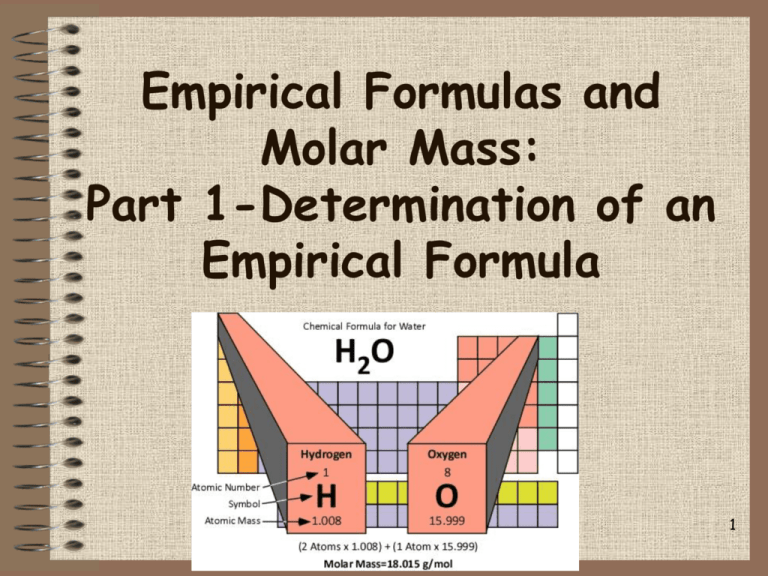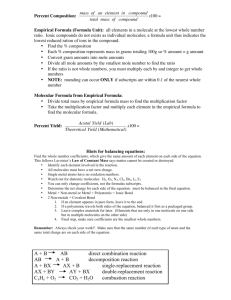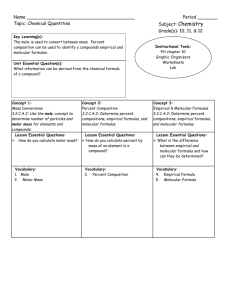Empirical Formulas and Molar Mass: Part 1
advertisement

Empirical Formulas and Molar Mass: Part 1-Determination of an Empirical Formula 1 Objectives • -Explain what empirical formulas are • -Be able to determine empirical formulas using charges or using experimental data 2 Empirical Formulas • Empirical formula (“formula unit”) -the lowest whole number ratio of atoms in an ionic compound • There are two ways to determine the empirical formula for a compound 1. Using charges (use your ions and this is easy) C CRISS O S S 2. Mathematically (yippee!!!) 3 Method #1 – Charges EX: Write the empirical formula for the compound formed by Na & P c. K & Ne Na3P Sr & Cl SrCl2 No compound d. Cu & Cl CuCl or CuCl2 4 Method #2 – Mathematically • Step 1:Use the info given in the problem and DA with the atomic mass of the element (from periodic tableround to 3 SDs) to find moles • Step 2:Take all the mole values and divide them by the SMALLEST one to figure out a ratio • Step 3: Use the answers as subscripts in the empirical formula 5 Law of Conservation of Mass Chemical Equation Na + Cl NaCl Reactants Products Mass of Reactants = Mass of Products Example: Na + Cl NaCl 5.0g + 5.0g = ? 10.0g 6 Atomic Mass of an Element = Mole • Each element has a unique atomic mass and this is a standard for each element • Atomic mass = mass of 1 mole of an element • The atomic masses are from the periodic table and we use grams 1 mole O = 6.02 x 1023 atoms O = 15.999 g O 1 mole Mg= 6.02 x 1023 atoms Mg= 24.305 g Mg 7 Empirical Formulas 7.06 g of silver combine with an excess of fluorine to produce 8.30 g of a compound Silver 7.06g + Fluorine 1.24g Ag?F? 8.30g Found by subtracting! 7.06 g Ag X 𝟏 𝒎𝒐𝒍𝒆 𝑨𝒈 𝟏𝟎𝟖 𝒈 𝑨𝒈 .𝟎𝟔𝟓𝟒 = .0654 moles Ag .𝟎𝟔𝟓𝟑 = 1.00 or 1 Ag1F1 1.24 g F X 𝟏 𝒎𝒐𝒍𝒆 𝑭 𝟏𝟗.𝟎 𝒈 𝑭 = .0653 moles F .𝟎𝟔𝟓𝟑 .𝟎𝟔𝟓𝟑 = 1.00 or 1 ANSWER = AgF 8 Empirical Formulas A compound contains 24.58% K, 35.81% Mn, and 40.50% O. Find the empirical formula (assume working with 100 grams of the compound and change percentages to grams) 24.58 g K X 35.81 g Mn X 40.50 g O X 1 𝑚𝑜𝑙𝑒 𝐾 39.1 𝑔 𝐾 = .629 mole K .𝟔𝟐𝟗 .𝟔𝟐𝟗 = 1.00 or 1 1 𝑚𝑜𝑙𝑒 𝑀𝑛 = .652 moles Mn 54.9 𝑔 𝑀𝑛 .𝟔𝟓𝟐 .𝟔𝟐𝟗 = 1.04 or 1 1 𝑚𝑜𝑙𝑒 𝑂 16.0 𝑔 𝑂 𝟐.𝟓𝟑 .𝟔𝟐𝟗 = 4.02 or 4 = 2.53 moles O 9 ANSWER = KMnO4 Uneven Empirical Formulas • When figuring empirical formulas mathematically, sometimes the resulting numbers don’t come out so clean • You can’t just assume and round how you choose 10 .05 Rule • This 0.05 rule allows for experimental error that occurs causing varied number values: – If a value is within .05 of a whole number (+0.05 or - 0.05), then the value may be rounded – Ex: 1.96 can be rounded to 2 • 1.07 cannot be rounded to 1 • 3.02 could be rounded to 3 • 1.93 cannot be rounded to 2 • If one value is not within .05 of a whole number, all the values must be multiplied by 11 an integer so all values fall within .05 of whole numbers Uneven Empirical Formulas 4.35 g sample of zinc is combined with an excess of the element phosphorus. 5.72 g of compound are formed. Calculate the empirical formula. Zinc + Phosphorous Zn?P? 4.35g 1.37g Found by 5.72g 4.35 g Zn X 𝟏 𝒎𝒐𝒍𝒆 𝒁𝒏 𝟔𝟓.𝟒 𝒈 𝒁𝒏 = .0665 moles Zn subtracting! .𝟎𝟔𝟔𝟓 .𝟎𝟒𝟒𝟐 = 1.50 X 2 = 3.00 or 3 Not within .05 of a whole number 𝟏 𝒎𝒐𝒍𝒆 𝑷 𝒈𝑷 1.37 g P X 𝟑𝟏.𝟎 = .0442 moles P .𝟎𝟒𝟒𝟐 = 1.00 X 2 = 2.00 or 2 .𝟎𝟒𝟒𝟐 12 ANSWER = Zn3P2 Let’s Do It!!! A compound is found to contain 72.3% Fe and 27.7% O by weight. Calculate the empirical formula. Assume in 100 g of compound there would be 72.3 g Fe and 27.7 g O 13 72.3g Fe 1 mole Fe X —————— 55.8 g Fe 1.30 mole = 1.00 1.30 mole = 1.30 mole Fe X 3 = 3.00 = 3 1 mole O 27.7g O X —————— = 1.73 mole O 16.0 g O 1.73 mole =1.33 X 3 = 3.99 = 4 1.30 mole Fe3O4 14 Objectives • -Explain what empirical formulas are • -Be able to determine empirical formulas using charges or using experimental data 15









